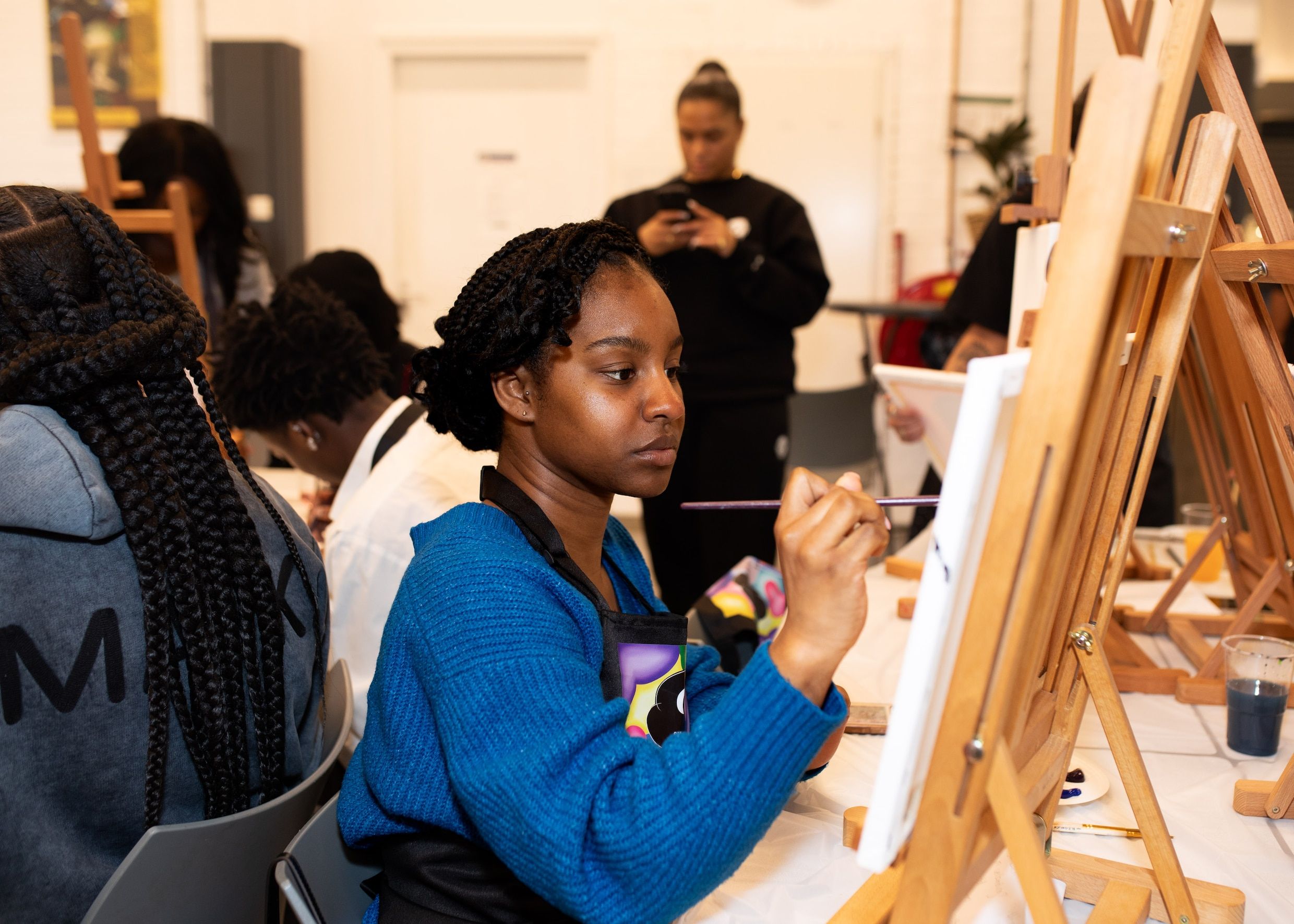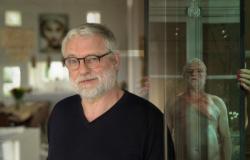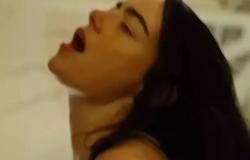“Dear people, I have great news: it is time to start painting your canvas!” Jack-of-all-trades Gabriela Akyea (22, artist, communications student at the AUAS, trainer at primary schools and art mediator in South East) has an infectious way to encourage the twenty participants in the Our Hidden Treasures workshop. “You can get your paint and brushes from Bridget.” “Hi Bridget!” the group repeats after her in unison.
Divided into groups of five, they sit in front of their easel, sipping a passion fruit cocktail. Large bowls with meatpies, made by Gabriella’s mother, are passed around and Afrobeats sound from the speaker. This Saturday afternoon is the second edition of the Paint & Conversate-afternoon in the Kazerne, a community center for local residents from young to old, in a former fire station in Reigersbos.
Brought over from America
Akyea was inspired for the meetings by the Paint & Sip phenomenon, a phenomenon that originated in America, where people come together to make art together in an accessible way while enjoying a drink. “During corona, I bought a canvas, paint and brushes at Action, got a drink and started painting. That’s how I made my first oil paintings.” After an exhibition in the Barracks, organized by Sankofa Archives, self-taught Akyea immediately sold one of her paintings to The Black Archives.
“I thought it would be nice to organize something at this location for young people between the ages of 18 and 25 from South East. I grew up in Holendrecht and discovered that young people from the neighborhood meet each other less often after high school. We pass each other on the street and don’t make a connection. During the Paint & Conversateworkshops, three of which are subsidized by the Amsterdam Art Fund, I want to bring people into contact with each other while painting. I want to open their eyes to the hidden treasures of their culture and let them learn from each other’s culture.”
First, Akyea takes the participants through a presentation, which they talk about with each other. “This time it is about the history of slavery and our personal history. I talk about cultural symbols, from jewelry to clothing, and from food to historical heroes and from music to art. I talk about the meaning of Ghanaian Adinkra symbols and the Surinamese carpet beater, but also about the American activist and heroine Harriet Tubman, who managed to free seventy slaves, and Yaa Asantewaa, the first and only female military leader of the West African Asante empire. But also about artists who inspire me, such as Van Gogh and Pick of the Petteflet, my favorite children’s book. I show the connections between the different cultures, such as the checkerboard pattern, which can be found in the traditional Ghanaian Kente and Surinamese Pangi fabrics.”
Trust your own strengths
It is especially important that the participants get to work in a relaxed, organic way, says Akyea. “I want them to learn to trust their own strengths. When people come here, they often say they can’t draw, but as a child you tried everything, without knowing if you could do it. I motivate them to just get started and I only give positive feedback. We all need someone to give you a push, that’s why I have a goodie bag for everyone afterwards containing a small canvas with easel, four tubes of paint and a brush.”
Business IT Manager Gabriella Addai (21) is working on her canvas at one of the tables. She has just discovered that a peer at her table also works in IT. “I would never have found out otherwise.” Addai is sketching a nyansapo, or wisdom knot, the Adinkra symbol for wisdom. “Painting clears my head, I think I’m completely lost for a moment. At the same time, today’s theme makes me think about my origins, which is not something I deal with every day, which also makes it interesting.”
Priscillia Sidibe (19), a student of applied psychology, is still staring at a blank canvas. She asks Akyea for help, and together they discuss some topics. She asks her to think of which symbols she knows from her own culture. Sidibe is reminded of the jewelry worn at weddings. “Do you know what they stand for? Not? Ask your mother about that when you get home,” Akyea encourages her. Sidibe came to Amsterdam from France when she was nine and went to live with her mother in Zuidoost. “I am very happy that she made that choice. In Lille I didn’t know people of color, here I got to know people from all kinds of different cultures, for example in a place like this.”

At the same table, Sikira Decaster (26) is already well on her way, she dips her brush in blue paint to paint waves: “This will be an ode to my parents, this is Kokomo Beach on Curaçao, where my mother comes from and next to it is the Nigerian flag, my father is from Nigeria. I only draw in my work, for my work as an activity supervisor in elderly care, so I always enjoy it a lot. Who knows, maybe I will pick it up at home afterwards, I will definitely give this painting to my mother.”
Zemeluna Dikan (19) says that she belongs to the Maroons, the descendants of enslaved people who fled and initially lived as a tribe in the interior of Suriname. Seuur paints the pattern of a pangi, the embroidered cloths worn by Maroon women at special moments, at the birth of a child or at the initiation of sixteen-year-old girls into women. “My mother has a lot of them in her wardrobe.” For her, the workshop is mainly a way to get to know other young people, she says.

Annabel Bahl (25), with a Dominican and Sierra Leonean background and raised in the Dennenrode flat and then Ganzenhoef, is inspired by the story about slave liberator Harriet Tubman, whom she had never heard of until today. “I love that she helped other people escape too. I also like to help people, just like Gabriela, I work at primary schools in South East and provide training to children in group 8 in preparation for secondary school.”
Akyea walks around and gives tips, occasionally she does a dance around the tables with her team of volunteers. Colorful images appear on all canvases, and an African flag or the continent of Africa appears on several canvases. Benito de Graav (20), manager at Patta, has painted an older Surinamese man with an afro, dressed in the school uniform of Surinamese children – green and yellow checkered. “What you learn as a child shapes you for the rest of your life and you never stop learning, even when you are old. It’s fun to do something I’ve never done before, it shows me what else is possible. ”
Everyone has been painting for an hour when Akyea turns down the music and asks everyone to clean the palettes and rinse the brushes. Finally, everyone presents the created work of art to the rest of the group. No one judges, no grades are handed out, only applause. A number of works of art are greeted with enthusiastic cheers, such as the canvas by fashion designer Trinity Williams (19): “When you see still lifes of a house in museums, they are always houses of white people. I therefore tried to depict a Ghanaian living room.”
Gabriela Akyea: “I was previously asked why I only talked about white artists in my presentation. I replied: because I want to push you to become the new wave of more diverse artists.”
You can register for Our Hidden Treasures via @gabriela.akeyea. Workshop costs: €8.70, including drinks, snacks, an apron and goodie bag. The next event is on May 4.
About the Barracks
In the Barracks in the heart of Reigersbos there is a community center that is a starting point for creatives, starting entrepreneurs and local residents. There are eighteen studios, a music production room, community workshop, flexible workplaces, (community) stage, a kitchen, coffee bar and a gym. Salsa lessons and comedy nights are organised, closet sales and Tante Nel’s flea market, and there is room for performances and exhibitions.
www.kazernereigersbos.org/ @kazernereigersbos
Tags: Paint Sip rise young people paint hidden treasures culture mocktail hand
-








